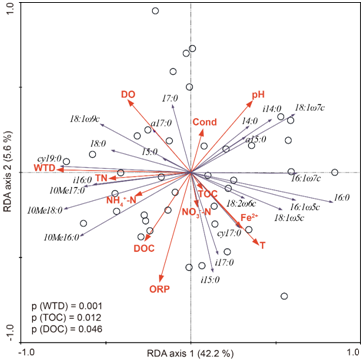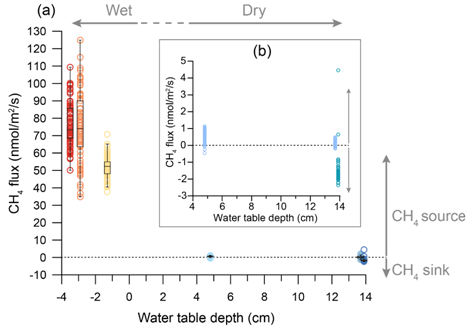On November 30, a journal of Nature Index on geosciences---Geochimica et Cosmochimica Acta published the research results of Professor Xie Shucheng's team from the State Key Laboratory of Biogeology and Environmental Geology, CUG: Variations in wetland hydrology drive rapid changes in the microbial community, carbon metabolic activity, and greenhouse gas fluxes, with doctoral student Zhang Yiming as the first author, Dr. David Naafs as the co-first author, and Professor Huang Xianyu as the corresponding author.
Wetlands play a crucial role in the carbon cycle as they are the largest natural source of methane, a potent greenhouse gas. Changes in wetland hydrology can alter the rate of greenhouse gas release from wetlands and have the potential to alter Earth’s carbon budget. However, the microbial dynamics underpinning these observations are poorly constrained. Here we combine monitoring of environmental parameters and greenhouse gas fluxes with monthly records of microbial phospholipid fatty acid (PLFAs) δ13C values to probe changes in microbial community and biogeochemistry in response to hydrological changes in a monsoon influenced subtropical wetland from central China. Our results show that water table depth is a key factor controlling the microbial community structure, with Gram-negative bacteria and actinobacteria increasing and fungi decreasing during dry and low water table periods. Meanwhile, the δ13C values of specific PLFAs decreased up to 12‰ during dry compared to wet periods. The extent of depletion varied, but PLFAs from Gram-negative bacteria were most depleted in 13C, indicative for a rapid increase in methanotrophy (methane consumption) during these dry periods. Furthermore, the methane emission of the wetland was drastically reduced and even had negative flux values during dry periods, suggesting that the increased methanotrophy led to a reduced methane flux and a temporary shift of the wetland from a methane source to a methane sink. Our results indicate that short-term hydrological variations lead to a rapid response in microbial community and carbon metabolic activity that directly influences wetland carbon dynamics and greenhouse gas emissions.

Fig. 1. Redundancy analysis of the fractional abundance of PLFAs and environmental parameters. The p values of three significant environmental control factors, WTD (p = 0.001), TOC (p = 0.012) and DOC (p = 0.046) are marked, while the p values of other environmental parameters are > 0.05. WTD = water table depth; TOC = total organic carbon; DOC = dissolved organic carbon; TN = total nitrogen; T = air temperature; ORP = oxidation–reduction potential; Cond = conductivity; DO = dissolved oxygen.

Fig. 2. δ13C values of PLFAs, bulk organic matter and DOC in the Dajiuhu wetland. Different PLFAs are classified according to their biological sources. (a) δ13C values of DOC, bulk, and PLFAs in all samples. Circles represent samples collected during wet periods, and triangles represent samples collected during dry periods. A total of 39 samples were analysed, but the concentration of some PLFAs in some samples was insufficient to obtain reliable δ13C values, so there are less than 39 points for some PLFAs (e.g., 15:0, 18:2ω6c). (b) Comparison of average δ13C values of DOC, bulk, and PLFAs during dry (WTD > 5 cm, grey curve) and wet (WTD < 5 cm, black curve) periods. Error bars represent the standard deviation of multiple samples in dry and wet periods, respectively. (c) The δ13C offset of DOC, bulk, and PLFAs between dry (WTD > 5 cm) and wet (WTD < 5 cm) periods. The δ13C offset is calculated by subtracting the average δ13C value of all samples with WTD > 5 cm from the average δ13C value of all samples with WTD < 5 cm. All peat samples from this study are included in this calculation.

Fig. 3. (a) Methane emission fluxes from the Dajiuhu wetland under different water table depth conditions. (b) Close-up of methane flux during the dry periods.
This study investigated the impact of rapid hydrological variations on the wetland microbial community and carbon metabolic activity. Through a high temporal-resolution environmental monitoring and monthly observations of molecular distribution and δ13C values of a suite of PLFAs across a period of seasonal water table fluctuations, together with monitoring of methane and CO2 emission flux, bulk geochemistry, peat porewater chemistry and nutrients in a subtropical wetland.
Professor Xie Shucheng, Professor Richard Pancost and Professor Richard Evershed participated in this research, and this project was funded by the National Natural Science Foundation (China) and the "111" talent program supported by the Ministry of Education.
Title: Variations in wetland hydrology drive rapid changes in the microbial community, carbon metabolic activity, and greenhouse gas fluxes
Authors: Yiming Zhang, B. David A. Naafs, Xianyu Huang*, Qingwei Song, Jiantao Xue, Ruicheng Wang, Meiling Zhao, Richard P. Evershed, Richard D. Pancost, Shucheng Xie
Journal:Geochimica et Cosmochimica Acta
DOI:10.1016/j.gca.2021.11.014
Available online:17 November 2021
Link to the paper:https://www.sciencedirect.com/science/article/pii/S0016703721006591